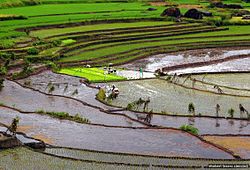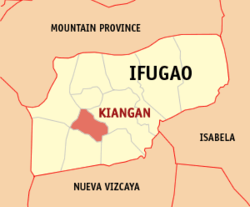Kiangan
Kiangan | |
|---|---|
| Municipality of Kiangan | |
 Nagacadan Rice Terraces | |
 Map of Ifugao with Kiangan highlighted | |
Location within the Philippines | |
| Coordinates: 16°46′39″N 121°05′16″E / 16.7775°N 121.0878°E | |
| Country | Philippines |
| Region | Cordillera Administrative Region |
| Province | Ifugao |
| District | Lone district |
| Barangays | 14 (see Barangays) |
| Government | |
| • Type | Sangguniang Bayan |
| • Mayor | Raldis Andrei A. Bulayungan |
| • Vice Mayor | Michelle Alice B. Baguilat |
| • Representative | Solomon R. Chungalao |
| • Municipal Council | Members |
| • Electorate | 12,347 voters (2022) |
| Area | |
• Total | 200.00 km2 (77.22 sq mi) |
| Elevation | 841 m (2,759 ft) |
| Highest elevation | 1,477 m (4,846 ft) |
| Lowest elevation | 416 m (1,365 ft) |
| Population (2020 census)[3] | |
• Total | 17,691 |
| • Density | 88/km2 (230/sq mi) |
| • Households | 3,965 |
| Economy | |
| • Income class | 4th municipal income class |
| • Poverty incidence | 10.56 |
| • Revenue | ₱ 111.3 million (2020), 48.09 million (2012), 53.52 million (2013), 61.5 million (2014), 68.87 million (2015), 75.58 million (2016), 85.82 million (2017), 91.63 million (2018), 100 million (2019), 119.3 million (2021), 161.6 million (2022) |
| • Assets | ₱ 259.3 million (2020), 55.96 million (2012), 62.2 million (2013), 65.92 million (2014), 85.26 million (2015), 132.6 million (2016), 174.5 million (2017), 210.3 million (2018), 235.7 million (2019), 288.5 million (2021), 311.2 million (2022) |
| • Expenditure | ₱ 82.97 million (2020), 44.74 million (2012), 44.72 million (2013), 45.4 million (2014), 48.67 million (2015), 53.74 million (2016), 67.56 million (2017), 92.7 million (2018), 74.83 million (2019), 92.63 million (2021), 95.74 million (2022) |
| • Liabilities | ₱ 48.11 million (2020), 16.89 million (2012), 42.13 million (2013), 16.02 million (2014), 24.77 million (2015), 29.22 million (2016), 52.4 million (2017), 48.3 million (2018), 51.69 million (2019), 51.91 million (2021), 42.17 million (2022) |
| Service provider | |
| • Electricity | Ifugao Electric Cooperative (IFELCO) |
| Time zone | UTC+8 (PST) |
| ZIP code | 3604 |
| PSGC | |
| IDD : area code | +63 (0)74 |
| Native languages | Ifugao Kallahan Tuwali Ilocano Tagalog |
| Website | kiangan |
Kiangan, officially the Municipality of Kiangan is a municipality in the province of Ifugao, Philippines. According to the 2020 census, it has a population of 17,691 people.[3]
Kiangan is the oldest town in the province. It derives its name from Kiyyangan, an ancient village near the bank of the Ibulao River across the Lagawe valley. The name Kiyyangan is enshrined in Ifugao mythology and is believed to be the dwelling of Wigan and Bugan, the mythological ancestors of the Ifugao. It was the former capital of Ifugao until the topology was deemed unfit and moved to neighboring Lagawe.
The Nagacadan Rice Terraces are part of the Rice Terraces of the Philippine Cordilleras World Heritage Site.
Geography
[edit]Barangays
[edit]Kiangan is politically subdivided into 14 barangays. [5] Each barangay consists of puroks and some have sitios.
- Ambabag
- Baguinge
- Bolog
- Bokiawan
- Dalligan
- Duit
- Hucab
- Julongan
- Lingay
- Mungayang
- Nagacadan
- Pindongan
- Poblacion
- Tuplac
Climate
[edit]| Climate data for Kiangan, Ifugao | |||||||||||||
|---|---|---|---|---|---|---|---|---|---|---|---|---|---|
| Month | Jan | Feb | Mar | Apr | May | Jun | Jul | Aug | Sep | Oct | Nov | Dec | Year |
| Mean daily maximum °C (°F) | 21 (70) |
22 (72) |
24 (75) |
25 (77) |
25 (77) |
25 (77) |
24 (75) |
24 (75) |
24 (75) |
24 (75) |
23 (73) |
21 (70) |
24 (74) |
| Mean daily minimum °C (°F) | 14 (57) |
15 (59) |
16 (61) |
18 (64) |
19 (66) |
19 (66) |
19 (66) |
19 (66) |
19 (66) |
17 (63) |
16 (61) |
15 (59) |
17 (63) |
| Average precipitation mm (inches) | 35 (1.4) |
46 (1.8) |
63 (2.5) |
117 (4.6) |
402 (15.8) |
400 (15.7) |
441 (17.4) |
471 (18.5) |
440 (17.3) |
258 (10.2) |
94 (3.7) |
68 (2.7) |
2,835 (111.6) |
| Average rainy days | 9.9 | 11.1 | 13.9 | 18.9 | 26.0 | 27.3 | 28.9 | 28.5 | 26.1 | 19.7 | 14.5 | 12.8 | 237.6 |
| Source: Meteoblue[6] | |||||||||||||
Demographics
[edit]| Year | Pop. | ±% p.a. |
|---|---|---|
| 1918 | 37,161 | — |
| 1939 | 16,146 | −3.89% |
| 1948 | 10,534 | −4.63% |
| 1960 | 12,689 | +1.56% |
| 1970 | 15,123 | +1.77% |
| 1975 | 15,935 | +1.05% |
| 1980 | 17,481 | +1.87% |
| 1990 | 21,329 | +2.01% |
| 1995 | 13,514 | −8.20% |
| 2000 | 14,099 | +0.91% |
| 2007 | 15,448 | +1.27% |
| 2010 | 15,837 | +0.91% |
| 2015 | 17,048 | +1.41% |
| 2020 | 17,691 | +0.73% |
| Source: Philippine Statistics Authority[7][8][9][10] | ||
In the 2020 census, the population of Kiangan, Ifugao, was 17,691 people,[3] with a density of 88 inhabitants per square kilometre or 230 inhabitants per square mile.
Locally spoken languages include Tuwali, Ayangan, Ilocano, Tagalog, and English.
Economy
[edit]Poverty incidence of Kiangan
5
10
15
20
25
30
2006
20.60 2009
22.86 2012
25.30 2015
24.20 2018
14.88 2021
10.56 Source: Philippine Statistics Authority[11][12][13][14][15][16][17][18] |
Agriculture and tourism are the main sources of local economic activities which supports commerce and trade among townsfolk. Its terraced rice fields do not only provide produce for the farmers but attract tourists as well.
Government
[edit]Local government
[edit]Kiangan, belonging to the lone congressional district of the province of Ifugao, is governed by a mayor designated as its local chief executive and by a municipal council as its legislative body in accordance with the Local Government Code. The mayor, vice mayor, and the councilors are elected directly by the people through an election which is being held every three years.
Elected officials
[edit]| Position | Name |
|---|---|
| Congressman | Solomon R. Chungalao |
| Mayor | Raldis Andrei A. Bulayungan |
| Vice-Mayor | Michelle Alice B. Baguilat |
| Councilors | Angelito D. Dulinayan |
| Lawrence A. Dulnuan Jr. | |
| Clarence B. Buyuccan | |
| Magdalena D. Piggangay | |
| Marcial D. Allaga | |
| Jason A. Bayawon | |
| James I. Talib | |
| Janni B. Albano |
Culture
[edit]- Nagacadan Rice Terraces
The Nagacadan Rice Terraces is a UNESCO Heritage Site and one of the many rice terraces in the province of Ifugao. The rice terraces cluster manifest a distinct feature - the fields are in ascending rows of terraces bisected by a river.
Located in Kiangan is the Kiangan Central School old home economics building, which marks the spot where the highest Commander of the Japanese Imperial Army, General Tomoyuki Yamashita (also known as the Tiger of Malaya), surrendered to the Filipino & American Forces on 2 September 1945.
References
[edit]- ^ Municipality of Kiangan | (DILG)
- ^ "2015 Census of Population, Report No. 3 – Population, Land Area, and Population Density" (PDF). Philippine Statistics Authority. Quezon City, Philippines. August 2016. ISSN 0117-1453. Archived (PDF) from the original on May 25, 2021. Retrieved July 16, 2021.
- ^ a b c Census of Population (2020). "Cordillera Administrative Region (CAR)". Total Population by Province, City, Municipality and Barangay. Philippine Statistics Authority. Retrieved 8 July 2021.
- ^ "PSA Releases the 2021 City and Municipal Level Poverty Estimates". Philippine Statistics Authority. 2 April 2024. Retrieved 28 April 2024.
- ^ "Province: Ifugao". PSGC Interactive. Quezon City, Philippines: Philippine Statistics Authority. Retrieved 12 November 2016.
- ^ "Kiangan: Average Temperatures and Rainfall". Meteoblue. Retrieved 8 March 2020.
- ^ Census of Population (2015). "Cordillera Administrative Region (CAR)". Total Population by Province, City, Municipality and Barangay. Philippine Statistics Authority. Retrieved 20 June 2016.
- ^ Census of Population and Housing (2010). "Cordillera Administrative Region (CAR)" (PDF). Total Population by Province, City, Municipality and Barangay. National Statistics Office. Retrieved 29 June 2016.
- ^ Censuses of Population (1903–2007). "Cordillera Administrative Region (CAR)". Table 1. Population Enumerated in Various Censuses by Province/Highly Urbanized City: 1903 to 2007. National Statistics Office.
- ^ "Province of Ifugao". Municipality Population Data. Local Water Utilities Administration Research Division. Retrieved 17 December 2016.
- ^ "Poverty incidence (PI):". Philippine Statistics Authority. Retrieved December 28, 2020.
- ^ "Estimation of Local Poverty in the Philippines" (PDF). Philippine Statistics Authority. 29 November 2005.
- ^ "2003 City and Municipal Level Poverty Estimates" (PDF). Philippine Statistics Authority. 23 March 2009.
- ^ "City and Municipal Level Poverty Estimates; 2006 and 2009" (PDF). Philippine Statistics Authority. 3 August 2012.
- ^ "2012 Municipal and City Level Poverty Estimates" (PDF). Philippine Statistics Authority. 31 May 2016.
- ^ "Municipal and City Level Small Area Poverty Estimates; 2009, 2012 and 2015". Philippine Statistics Authority. 10 July 2019.
- ^ "PSA Releases the 2018 Municipal and City Level Poverty Estimates". Philippine Statistics Authority. 15 December 2021. Retrieved 22 January 2022.
- ^ "PSA Releases the 2021 City and Municipal Level Poverty Estimates". Philippine Statistics Authority. 2 April 2024. Retrieved 28 April 2024.
- ^ "2019 National and Local Elections" (PDF). Commission on Elections. Retrieved March 13, 2022.







